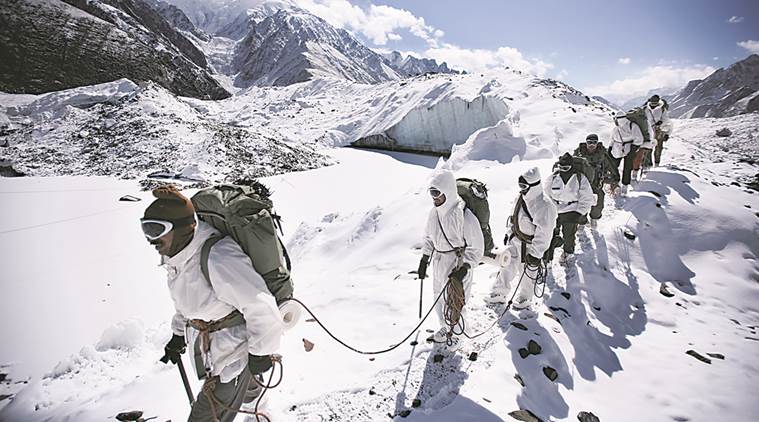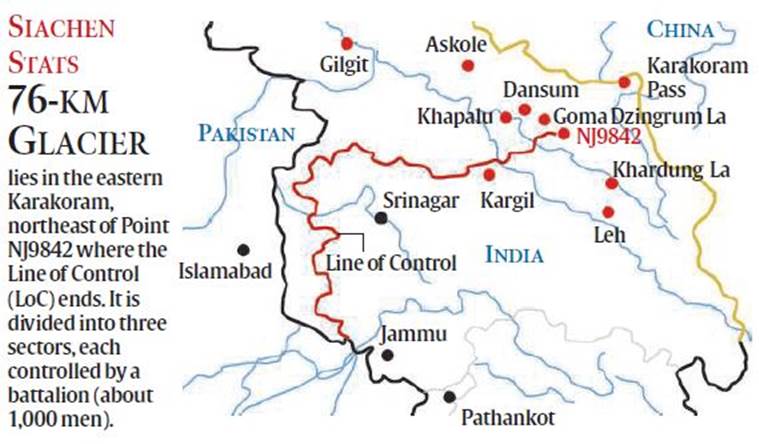- India
- International
Siachen: Death (and some glory) at 20,000 ft
PRANAV KULKARNI puts together details of the three-decade-old war at the world’s highest battlefield
 Soldiers are trained at the Siachen Battle School, and undergo acclimatisation schedules before being inducted. (Source: Express photo by Praveen Khanna)
Soldiers are trained at the Siachen Battle School, and undergo acclimatisation schedules before being inducted. (Source: Express photo by Praveen Khanna)
In the northern sector, the Siachen glacier is separated from the Baltoro glaciers by the Conway Saddle (or pass). Several mountaineering peaks lie to the northwest of the Saddle; access to peaks such as K2 is controlled by Pakistan. The Sia La and Bilafond La passes through the Saltoro ridge provide access to the Siachen glacier from the west. The Nubra river emerges from the southernmost tip of Siachen glacier.
Standing Guard
The Siachen Brigade is headquartered at Partapur; on the Pakistani side, the Brigade HQ is at Khapalu. Troops are deployed at heights between 18,000 feet and 23,000 feet; forward positions have small posts (perhaps 75-80 along the length of the glacier) manned by 10-15 soldiers each. Forward troops are supported by artillery positions and a logistics supply chain extending to the 14 Corps HQ in Leh, which is under the operational command of the Northern Command. Troops serve for between 1 and 3 months at a post, and move between high-altitude posts and back. Soldiers are trained at the Siachen Battle School, and undergo acclimatisation schedules before being inducted.

Crippling Challenges
The Cold
Temperatures below minus 55 degrees Celsius; blizzards at 100-150 knots (185-275 km/hr) are not uncommon. The extreme cold causes life-threatening high-altitude pulmonary oedema (HAPO), or the accumulation of fluid in the lungs, one of the main causes of death on Siachen. Specialised multilayered clothing prevents excessive sweating; there have been cases of sweat becoming ice inside gloves and shoes, causing frostbites. Carbon monoxide poisoning is also a cause of death — soldiers have sometimes been found dead after having fallen asleep with heating devices burning within fibre huts.
The Terrain
Avalanches, like the one on February 3 that killed Lance Naik Hanamanthappa Koppad and his comrades, add to the dangers of the terrain, which is dotted with virtually bottomless crevasses. Soldiers stick to beaten tracks, and often walk roped to each other. Daily caloric requirements could be as high as 5,000 Kcal per day — and soldiers, despite being given a special high-carbohydrate, high-fibre, low-salt diet, lose 5-6 kg during their deployment.
The Supplies
Supplies and rations are dropped from helicopters that operate from the Leh and Thoise airbases; the logistics chain for the glacier starts from railheads in Jammu and Pathankot from where they are transported to Leh via Srinagar and Kargil. Supplies also reach the base camp via Khardung La. There is no road beyond the base camp; the Army has, however, established logistics hubs along the route. Sometimes, rough weather leads to supplies packets dropped by choppers drifting off course and getting destroyed.
Killing Fields

Since 1984, the Army has lost 879 lives on the glacier, including the 10 who perished earlier this month. On December 11, 2015, the government told Parliament that 33 officers, 54 Junior Commissioned Officers and 782 men of other ranks had died until then.
Allowances
The Seventh Central Pay Commission has recommended an increase in the Siachen Allowance. If accepted by the government, the monthly allowance of officers will increase from Rs 21,000 to Rs 31,000; that of jawans and JCOs from Rs 14,000 to Rs 21,000.
More Explained
EXPRESS OPINION
Apr 26: Latest News
- 01
- 02
- 03
- 04
- 05










































